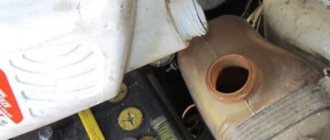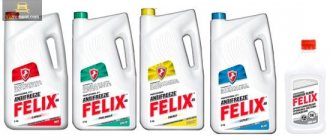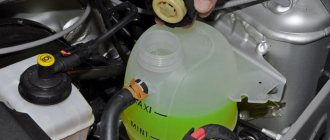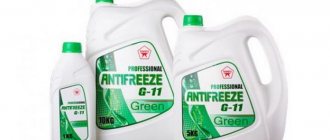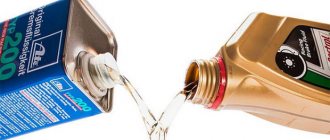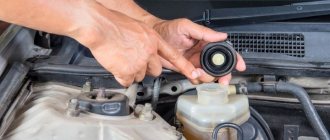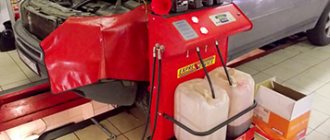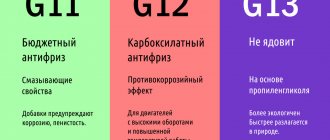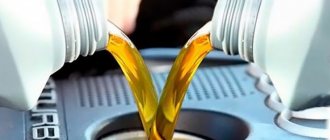Antifreeze compatibility ensures mixing of different coolants (coolants). In particular, different classes, colors and specifications. However, it is necessary to add or mix different coolants in full accordance with the antifreeze compatibility table. If you neglect the information given there, then, at best, the resulting coolant will not meet the standards and will not cope with the tasks assigned to it (to protect the engine cooling system from overheating), and at worst will lead to corrosion of the surface of individual parts of the system, reducing the service life of the engine. oil by 10...20%, increased fuel consumption by up to 5%, the risk of replacing the pump and other unpleasant consequences.
Types (types) of antifreeze
Traditional (IAT, Inorganic Acid Technology)
Silicate coolants containing phosphates and nitrites. They are considered obsolete and are not used as the first fill in factories.
Carboxylate (OAT, Organic Acid Technology)
Improved coolants containing only organic (carboxylate) corrosion inhibitors. Does not contain amines, nitrites, phosphates, borates and silicates.
Service life - up to 5 years or 250,000 km.
Color - bright red or lilac-violet.
Hybrid (HOAT, Hybrid Organic Acid Technology)
Coolants containing, in addition to organic (carboxylate) corrosion inhibitors, also inorganic silicates (European technology), nitrites (American technology) or phosphates (Asian technology).
A distinctive property of hybrid coolants is their good resistance to cavitation. The fact is that anti-cavitation additives are inorganic salts (nitrites, borates, phosphates and molybdates), which are completely absent in carboxylate-type antifreezes.
This is why commercial vehicles (trucks, quarry vehicles, diesel locomotives, etc.) mainly use hybrid coolants, since their engines use the so-called. “wet” liners, which are especially susceptible to cavitation.
Service life - up to 3 years or 100,000 km.
Color - green, turquoise, blue or yellow.
Lobrid (SiOAT, NOAT, POAT)
The name comes from "Low Hybrid", i.e. "low-hybrid" technology. The latest antifreezes, in which organic corrosion inhibitors are supplemented with a small amount of mineral ones. They provide improved protection against corrosion of aluminum engine parts, and also have an increased boiling point - up to 135 degrees Celsius, which allows their use in powerful, thermally loaded engines.
Service life - up to 10 years or 200,000 km
Color - bright red or lilac.
How to check compatibility
If you wish, you can check the compatibility of the coolant yourself in “garage” conditions.
Antifreeze mixing
This method is comparable to testing for an allergic reaction. You need to take a sample of the liquid poured into the system and a sample of the one you plan to add. Next, mix them in equal proportions and monitor the reaction. If after 5-10 minutes a reaction occurs, the color changes to brown, a precipitate forms or foam appears, then this indicates incompatibility of the samples. There is no way to mix them. If everything proceeds calmly, then the liquids can be diluted. To be sure, it is best to additionally heat the mixture to an operating temperature of 80-90°C.
You need to mix antifreeze, as they say, “wisely.” It is best to avoid such situations altogether and fill only with recommended fluids. If such a situation occurs, then you need to mix some classes, and not just colors, since color does not always indicate composition or category. For example, the Japanese use color to highlight a liquid’s resistance to frost.
What is the difference between antifreezes
Silicate-type antifreeze completely envelops the inner walls of the cooling system, protecting it from corrosion. Already existing pockets of corrosion are localized by carboxylate additives. The disadvantages of such antifreezes include reduced heat dissipation (due to the film that protects against corrosion) and a relatively short service life.
Carboxylate-type antifreezes do not form a protective film; they are adsorbed only in places where corrosion occurs, forming a protective layer no thicker than 0.1 microns, thereby providing excellent heat removal.
Let's start with the shade
What does the difference in shades mean between the antifreeze version G11 and the newer G12? The generally accepted classification of cooling mixtures in the automotive world was created at one time by Volkswagen in Europe. At that time, it was proposed to produce cooling mixtures of the so-called inorganic properties with advanced characteristics (G11) - blue and green antifreezes with numerous additives. Also organic antifreeze. origin (designated as G12) - usually produced in pink and red colors.
Important: this established shade system is used quite often, but still is not an established standard. In other words, there is practically nothing obliging companies to engage in such release of products to the market and somehow adhere to the technology.
Often manufacturing companies try to paint engine mixtures in a proprietary or specific shade. That is why, when choosing a new antifreeze for your engine, you should not pay attention to the shade, but simply consider the accepted product labeling.
The basis of each composition for cooling a motor of any type is a chemical base called ethylene glycol, or the base may be called propylene glycol. These substances can have a huge coefficient of so-called temperature increase, as well as a weak freezing point of the mixture. Among other things, the mixture for cooling the engine usually includes plain water and several additives for better service of the mixture for the benefit of the engine.
It is worth considering that manufacturing companies add additives to many types of G11 that can suppress the corrosion process during operation of the mixture. It also contains fluorescent additives and anti-foam additives with anti-cavitation additives.
VolksWagen antifreeze classification
The names of antifreezes “G11”, “G12”, “G13” and their compositions familiar to many car enthusiasts were invented by the VolksWagen concern.
G11 (VW TL 774-C)
Coolant intended for some domestic and foreign cars manufactured before 1996. The composition includes additives based on mineral substances: salts of nitric, phosphoric, silicate and boric acids. Since the protective layer is destroyed by vibration, it is recommended to replace such antifreeze annually. The maximum period is 3 years.
G12 (VW TL 774-D)
A carboxylate composition that has a good ability to prevent corrosion processes on the surface of cooling system parts. Does not contain nitrites, silicates and phosphates. It is forbidden to mix with G11 antifreeze.
G12+ (VW TL 774-F)
A more advanced carboxylate composition based on ethylene glycol. One advantage is the ability to mix with G11, but in this case the service life is reduced to 2 years.
G12++ (VW TL 774-G)
The newest carboxylate antifreeze, which in addition to organic additives contains silicate components. Sometimes this composition is called hybrid. Can be mixed with any “G” series coolant.
G13 (VW TL 774-J)
The main difference from the G12 series antifreeze is a different base, namely propylene glycol, which is a more environmentally friendly substance than ethylene glycol. Therefore, it is not recommended to mix it with other antifreezes. In rare cases can be mixed with G12+ and G12++
Is it possible to use G12 antifreeze instead of G11?
Complete replacement of G11 antifreeze with carboxylate G12 is only possible if the engine parts do not contain non-ferrous metals such as copper or brass. That is why when choosing antifreeze, we recommend following the recommendations of your car manufacturer.
What happens when you mix different colors?
Hands down, nothing will happen if you mix formulations from different manufacturers, although there are certain conditions. Situations can be different, including force majeure, so read the ingredients first. If green G11 is mixed with green, but from a different manufacturer, with the most similar parameters, the engine will not be damaged. This also applies to other standards. Only coolant products of the same color and additives can be mixed with each other.
Now about the “traffic light”. As mentioned above, the same G11/12/13 can have a wide palette of shades. Antifreeze of different colors with an identical formula will interact perfectly with each other . The main headache for motorists is the G13 in purple and yellow. Many are afraid that they are completely different, although this is fundamentally false. Let's start with the fact that this antifreeze is universal in nature and has a double portion of additives that get along with each other without any special consequences. You will just get a new shade, nothing more.
International standards for coolants
BS 6580
Antifreeze BS 6580 is intended for engines of cars, trucks, vans and motorcycles. According to the standard, coolants of this standard must be based on MEG (monoethylene glycol) and a complex of inorganic additives.
Not recommended for use in cooling systems of engines manufactured after 2005.
ASTM D 3306
The specification contains requirements for ethylene glycol or propylene glycol coolants used in engine cooling systems of automobiles or other light commercial vehicles. ASTM D 3306 standard includes silicate-carboxylate antifreezes that have a limited service life (up to 3 years). Prone to forming small amounts of precipitation. They have standard anti-corrosion properties. Not recommended for use in engine cooling systems manufactured after 2010
ASTM D 4985
MEG-based coolant with low silicate content, designed for cooling systems of heavily loaded high-power engines. Effectively protects against corrosion down to at least –36.4°C. Requires the addition of SCA additives (nitrites, molybdates, etc.) in order to be suitable for severe operating conditions.
ASTM D 6210.
Standard specification for glycol coolants that do not require prior addition of SCA additives.
JIS K 2234
Formally, any antifreeze concentrate based on ethylene glycol meets this standard. The type of additives is not regulated, so antifreeze of this standard can be either carboxylate, hybrid or silicate. Mandatory for all Japanese car manufacturers.
Let's sum it up
The engine is one of the most expensive components of a car, so its maintenance and functionality should be treated with the utmost responsibility. High-quality cooling of the power unit is the key to its long operational period, therefore experimenting with antifreeze is more than unreasonable. Fill the system only with refrigerants that, in terms of technical properties, absolutely comply with the requirements of the car manufacturer - this will help you avoid many problems with the performance of the vehicle and will significantly extend its service life.
Antifreeze or antifreeze?
The well-known coolant “Antifreeze” was developed at the GosNIIOKhT Institute in the Department of Organic Synthesis Technology (hence the name of the product). Tosol-AM was produced only at state-owned enterprises of the USSR. After the collapse of the Soviet Union, many small enterprises began to produce Tosol. However, completely different liquids could already be produced under this name.
Antifreeze is a silicate antifreeze, therefore, it can be replaced with carboxylate, hybrid or lobrid antifreeze. In this case, you should remember about the compatibility of antifreeze and various metals.
The most important question: can G13 and G12 be mixed?
Let's look specifically at products for VAG. On expansion tanks of the cooling system you can most often find the marking G12 (with or without pluses).
And on the assembly line, especially in European versions, where environmental issues come first, G13 is poured. Vehicle documentation does not provide for compatibility between G12 and G13.
That is, there is no prohibition or explicit permission. However, the compositions of the additives are identical from a chemical point of view. Therefore, these compositions can be mixed.
The practical meaning is unclear:
- if your coolant level has decreased due to evaporation, you only need to add water, no chemicals;
- if the radiator is damaged, you will still drain all the antifreeze to repair the iron, there will be no mixing;
- To completely replace the coolant, there are no problems at all: the old antifreeze is drained, washed with distillate, and new one is poured in.
But mixing other types of anti-freeze with G13 is unacceptable. Jelly-like lumps form, clogging the radiator honeycombs.
About the compatibility of G13 generation antifreeze with other liquids - video


